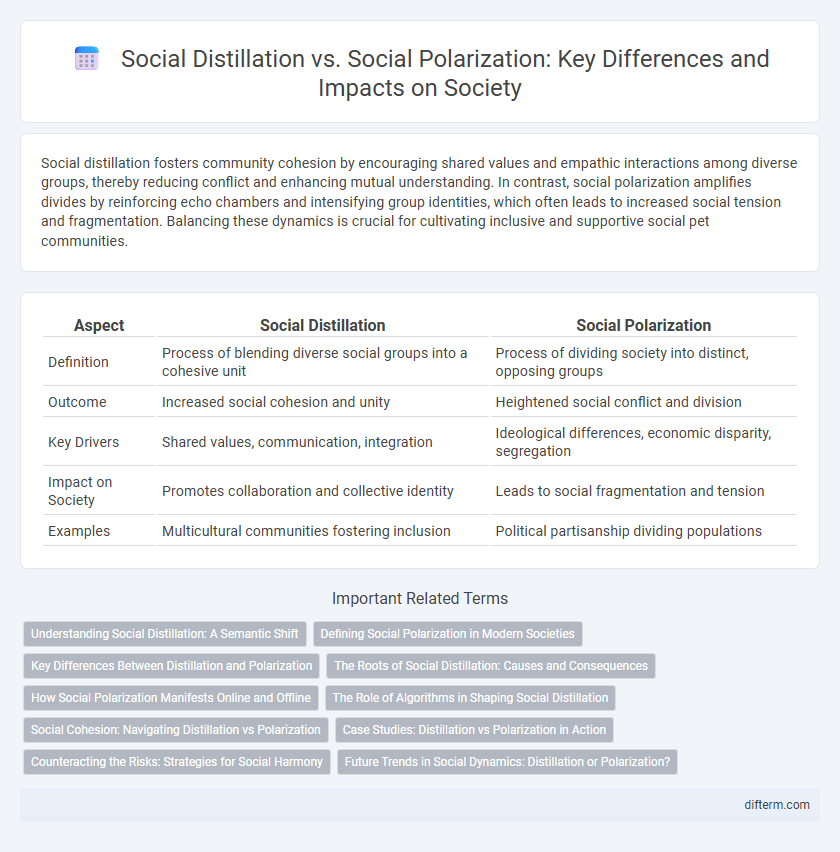Social distillation fosters community cohesion by encouraging shared values and empathic interactions among diverse groups, thereby reducing conflict and enhancing mutual understanding. In contrast, social polarization amplifies divides by reinforcing echo chambers and intensifying group identities, which often leads to increased social tension and fragmentation. Balancing these dynamics is crucial for cultivating inclusive and supportive social pet communities.
Table of Comparison
| Aspect | Social Distillation | Social Polarization |
|---|---|---|
| Definition | Process of blending diverse social groups into a cohesive unit | Process of dividing society into distinct, opposing groups |
| Outcome | Increased social cohesion and unity | Heightened social conflict and division |
| Key Drivers | Shared values, communication, integration | Ideological differences, economic disparity, segregation |
| Impact on Society | Promotes collaboration and collective identity | Leads to social fragmentation and tension |
| Examples | Multicultural communities fostering inclusion | Political partisanship dividing populations |
Understanding Social Distillation: A Semantic Shift
Social distillation represents a semantic shift where diverse social opinions converge into shared core beliefs, fostering unity despite differences. Unlike social polarization, which amplifies divisions and entrenches opposing views, social distillation emphasizes common narratives and mutual understanding. This process often results in more cohesive communities and promotes collaborative problem-solving through aligned social values.
Defining Social Polarization in Modern Societies
Social polarization in modern societies refers to the increasing division of populations into distinct and opposing social groups based on economic status, political beliefs, or cultural identities. This phenomenon intensifies social inequality and reduces opportunities for cross-group dialogue and cooperation. Understanding social polarization is crucial for addressing challenges related to social cohesion, political stability, and inclusive policy development in contemporary societies.
Key Differences Between Distillation and Polarization
Social distillation refers to the process of simplifying complex social interactions into more manageable or essential elements, promoting understanding and cohesion within communities. In contrast, social polarization involves the division of societal groups into contrasting extremes, leading to increased conflict and reduced social unity. Key differences lie in distillation fostering integration and consensus, while polarization amplifies division and ideological entrenchment.
The Roots of Social Distillation: Causes and Consequences
Social distillation arises from increasing economic disparities, cultural fragmentation, and digital echo chambers that reinforce social homogeneity within distinct groups. These causes lead to diminished cross-group interactions, escalating societal segregation and weakening social cohesion. Persistent social distillation can result in reduced empathy, lower trust in institutions, and heightened vulnerability to misinformation, contributing to long-term social instability.
How Social Polarization Manifests Online and Offline
Social polarization manifests online through the formation of echo chambers where users engage primarily with like-minded individuals, reinforcing existing beliefs and increasing ideological divides. Offline, it appears in segregated social networks and community fragmentation, limiting interactions between diverse groups and fostering misunderstandings. Algorithms on social media platforms amplify these divisions by promoting content that evokes strong emotional reactions, deepening societal rifts both digitally and physically.
The Role of Algorithms in Shaping Social Distillation
Algorithms on social media platforms often amplify social distillation by curating content that reinforces users' existing beliefs, leading to more homogeneous online communities. This selective exposure intensifies echo chambers where similar viewpoints dominate, reducing exposure to diverse perspectives and fostering social distillation. By prioritizing engagement metrics, algorithms inadvertently support cognitive clustering and filter bubbles, thereby shaping social distillation more prominently than broad social polarization.
Social Cohesion: Navigating Distillation vs Polarization
Social distillation enhances social cohesion by fostering shared values and mutual understanding among diverse groups, while social polarization heightens divisions, reducing trust and cooperation within communities. Effective navigation between these dynamics requires policies that encourage inclusive dialogue and equitable resource distribution to bridge ideological gaps. Strengthening social cohesion depends on balancing the forces of integration and differentiation to create resilient, connected societies.
Case Studies: Distillation vs Polarization in Action
Case studies reveal distinct outcomes where social distillation fosters community cohesion and shared identity, while social polarization intensifies division and ideological extremes. Research from urban neighborhoods illustrates how inclusive public spaces promote distillation by facilitating diverse interactions, contrasting with segregated areas where polarization entrenches social rifts. Analyzing digital platforms demonstrates that algorithm-driven echo chambers exacerbate polarization, whereas deliberate cross-group dialogues encourage distillation and reduce societal fragmentation.
Counteracting the Risks: Strategies for Social Harmony
Implementing community-based dialogue programs enhances understanding and reduces social polarization by fostering empathy among diverse groups. Promoting inclusive media representations and equitable economic opportunities addresses root causes of social distillation, strengthening social cohesion. Policy interventions such as anti-discrimination laws and education reforms reinforce social harmony by mitigating divisive narratives and systemic inequalities.
Future Trends in Social Dynamics: Distillation or Polarization?
Emerging social dynamics indicate a complex interplay between social distillation, where diverse groups converge through inclusive dialogue, and social polarization, characterized by increasing ideological divides amplified by digital echo chambers. Future trends suggest the role of algorithmic interventions and digital literacy initiatives will be critical in mitigating polarization while promoting cohesive social fabrics. Advances in AI-driven content curation and policy reforms targeting misinformation are expected to shape the trajectory toward either enhanced social integration or deepened societal fragmentation.
social distillation vs social polarization Infographic

 difterm.com
difterm.com